What do the two goats in Leviticus 16 represent?
This wonderful chapter deals with the “Day of Atonement” when the high priest would go into the Most Holy Place with sacrificial blood to make atonement for himself and for all the people of Israel. Various sin offerings and burnt offerings are mentioned in this detailed chapter, but we will limit ourselves to those verses which speak of the “two goats” and try to get a clear picture of what they represent.
In verse 5 we read, “And he shall take of the congregation of the children of Israel two kids of goats for a sin offering.” Verses 7-8 give us more details about these two goats, “And he shall take the two goats, and present them before the LORD at the door of the tabernacle of the congregation. And Aaron shall cast lots upon the two goats; one lot for the LORD, and the other lot for the scapegoat.” Verse 5 teaches us that the two goats together constituted one sin offering, yet verses 7-8 inform us that this offering would accomplish two different things, one for the Lord, and one for the people who would be represented by the scapegoat. We believe that these two goats symbolize TWO DIFFERENT ASPECTS OF ATONEMENT; the “lot for the LORD” would satisfy God’s holiness, and the “lot for the scapegoat” would meet the need of the sinner by removing his sins.
We see the FIRST GOAT offered in verses 15-19 where the blood that was shed was used to cleanse the Holy Place. They read, “Then shall he kill the goat of the sin offering…and bring his blood within the vail, and do with that blood as he did with the blood of the bullock, and sprinkle it upon the mercy seat, and before the mercy seat. And he shall make atonement for the holy place, because of the uncleanness of the children of Israel, and because of their transgressions in all their sins…and he shall go out unto the altar that is before the LORD, and make an atonement for it; and shall take of the blood of the goat, and put it upon the horns of the altar round about. And he shall sprinkle of the blood upon it with his finger seven times, and cleanse it, and hallow it from the uncleanness of the children of Israel.” All of this was done “for the LORD,” for God is holy and in order to provide forgiveness for guilty sinners an acceptable sacrifice had to be made. This offering pictures the perfect sacrifice Christ made on the cross to satisfy God’s holy demands against sin so that God could offer men forgiveness based on that sacrifice. 1 John 4:10 speaks to this, “Herein is love, not that we loved God, but that He loved us, and sent His Son to be the propitiation for our sins.” The word “propitiation” means “a satisfying sacrifice” and in the death of Christ, God is satisfied! This is what is represented by the FIRST GOAT.
The SECOND GOAT is presented in verses 10 and 20-22, “But the goat, on which the lot fell to be the scapegoat, shall be presented alive before the LORD, to make an atonement with Him, and to let him go for a scapegoat into the wilderness…he shall bring the live goat: and Aaron shall lay both his hands upon the head of the live goat, and confess over him all the iniquities of the children of Israel, and all their transgressions in all their sins, putting them upon the head of the goat, and shall send him away by the hand of a fit man into the wilderness: and the goat shall bear upon him all their inquities unto a land not inhabited.” The word “scapegoat” is the Hebrew word Azazel, meaning “goat of departure.” Once the sins of Israel were confessed they were transferred to the goat that then carried them away into the wilderness. This is a beautiful picture to us of Christ bearing the sins of all who would confess their sins and believe on Him as their Savior. The believer knows that their sins were laid on Christ, as we see in Isaiah 53:6, “the LORD hath laid on Him the iniquity of us all.” And every believer is assured that Christ bore the judgment for those sins on Calvary, which Peter declared in 1 Peter 2:24, “Who His own self bare our sins in His own body on the tree.” Because Christ bore our sins, they have been removed from God’s sight and we can claim the promise of Psalm 103:12, “As far as the east is from the west, so far hath He removed our transgressions from us.” This is the blessed truth represented by the SECOND GOAT. (183.3) (DO)
